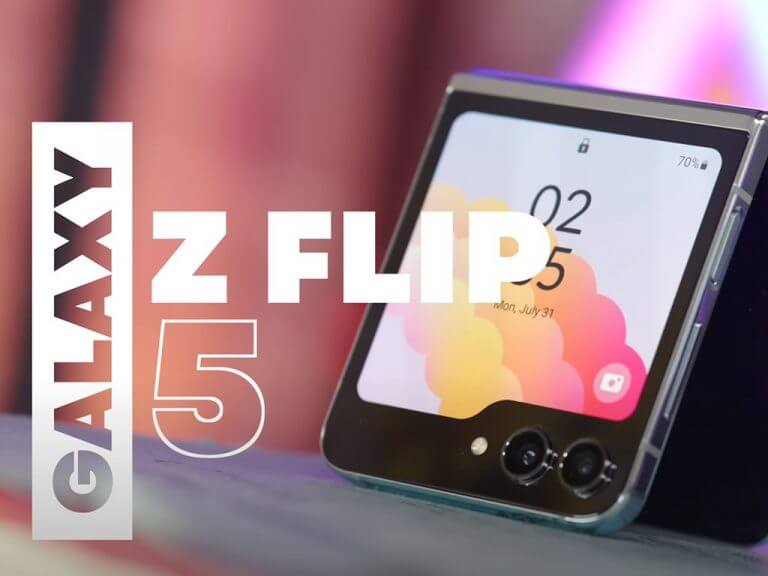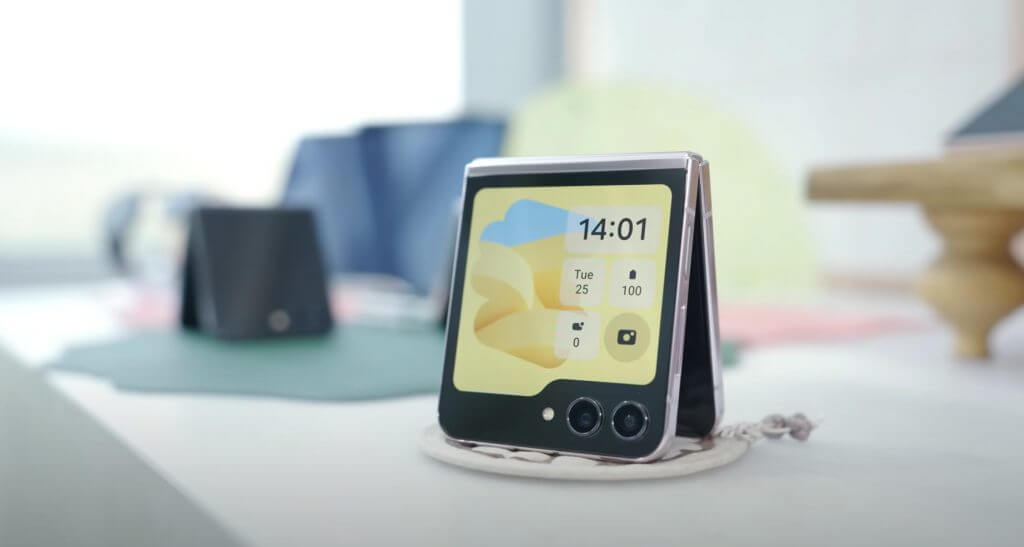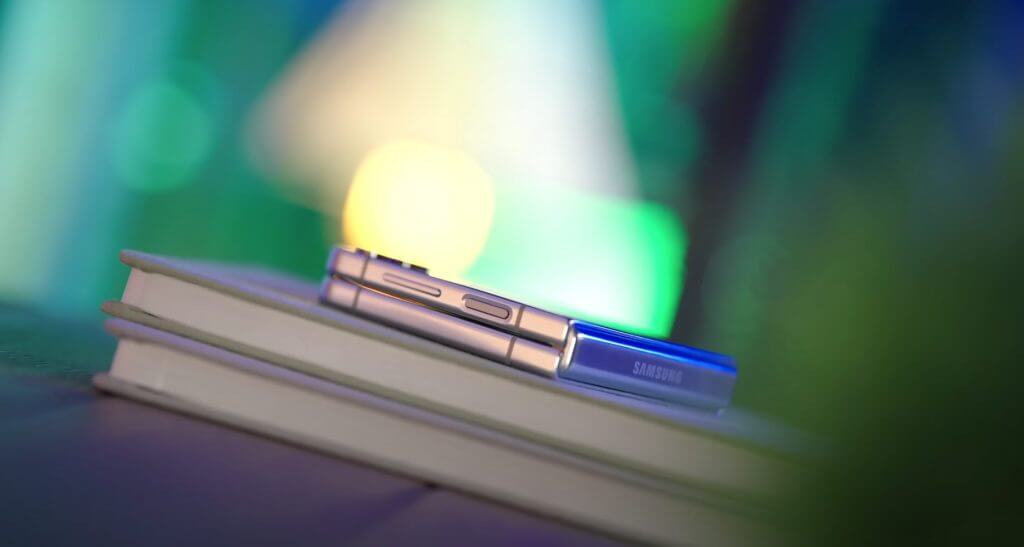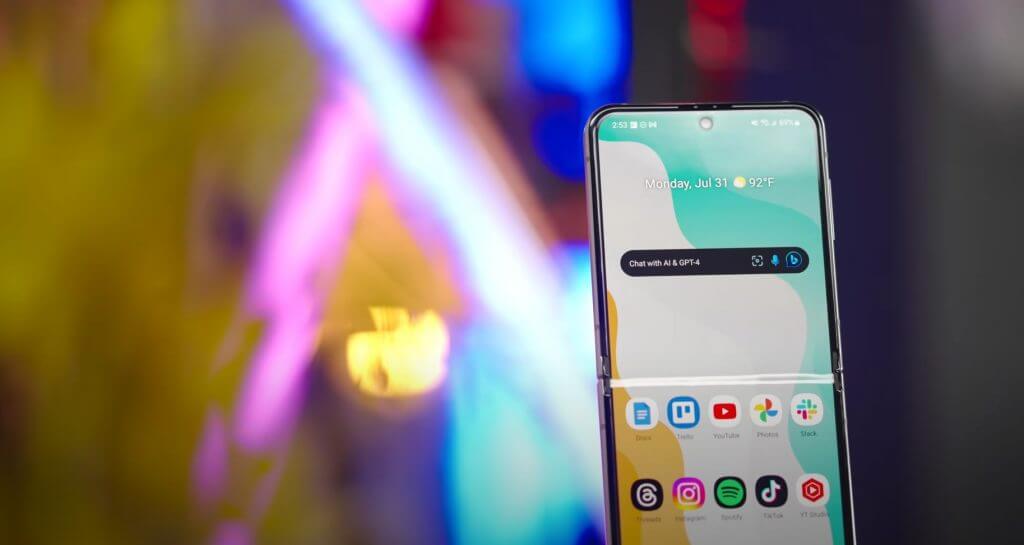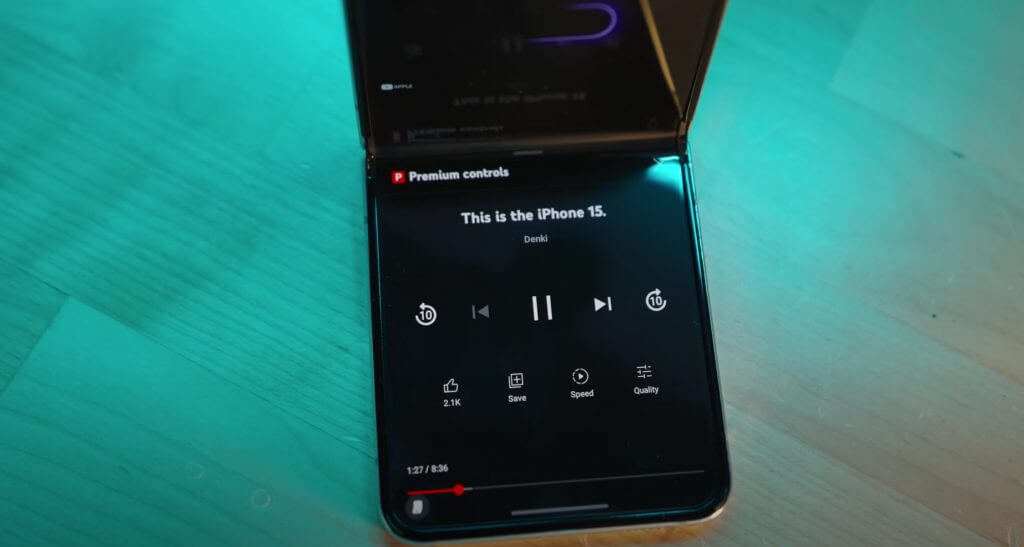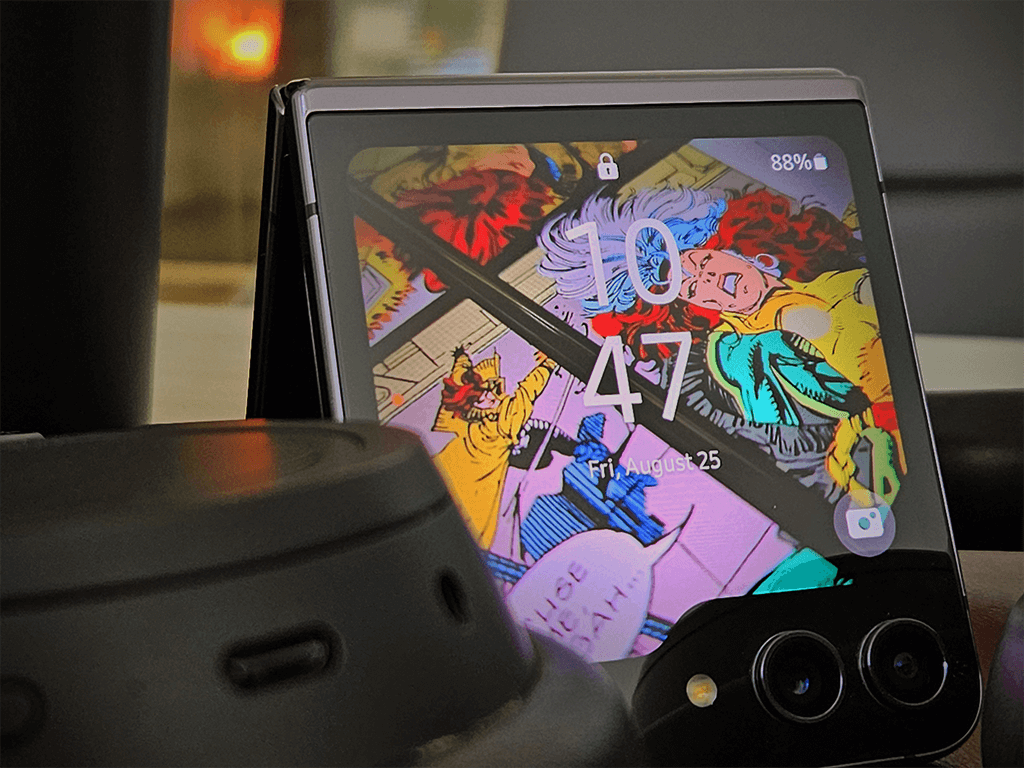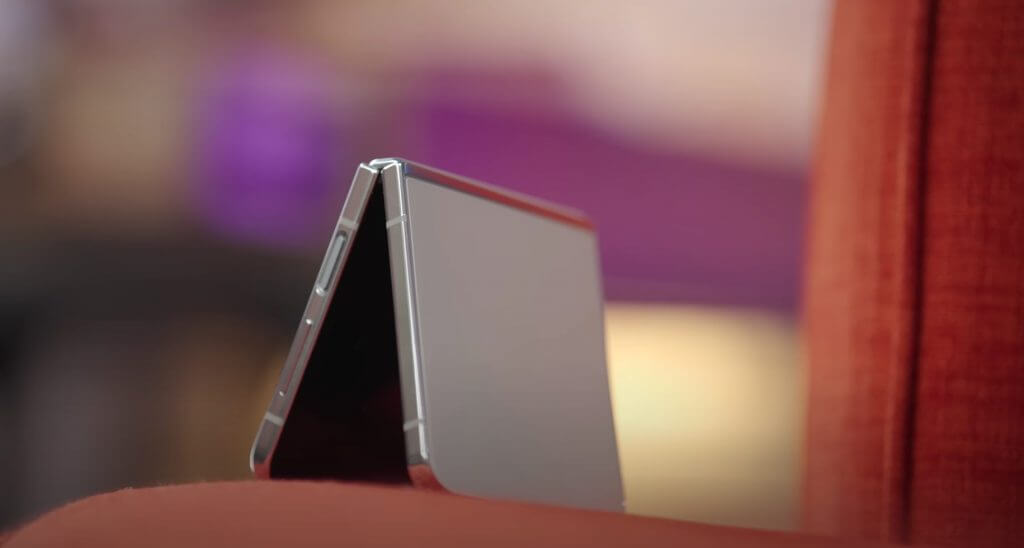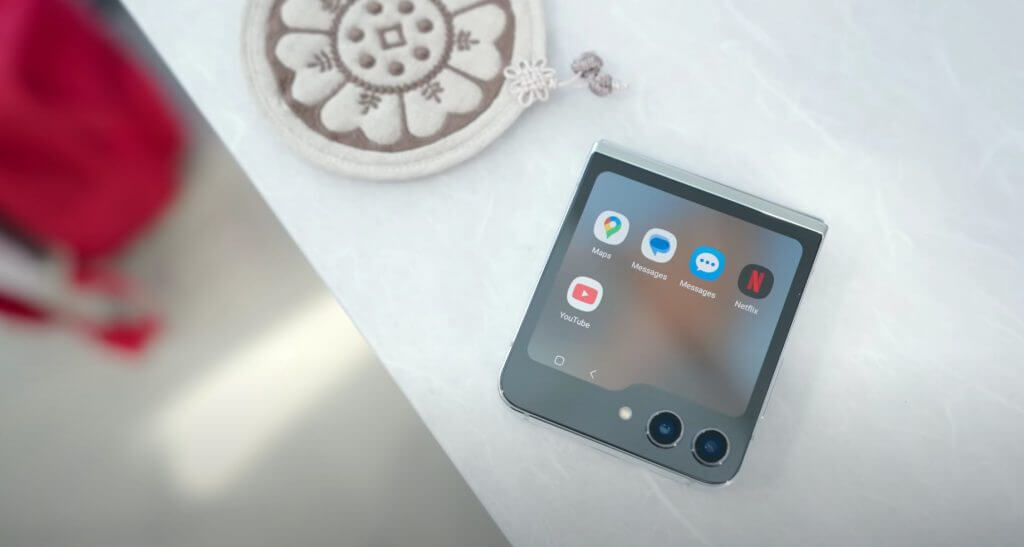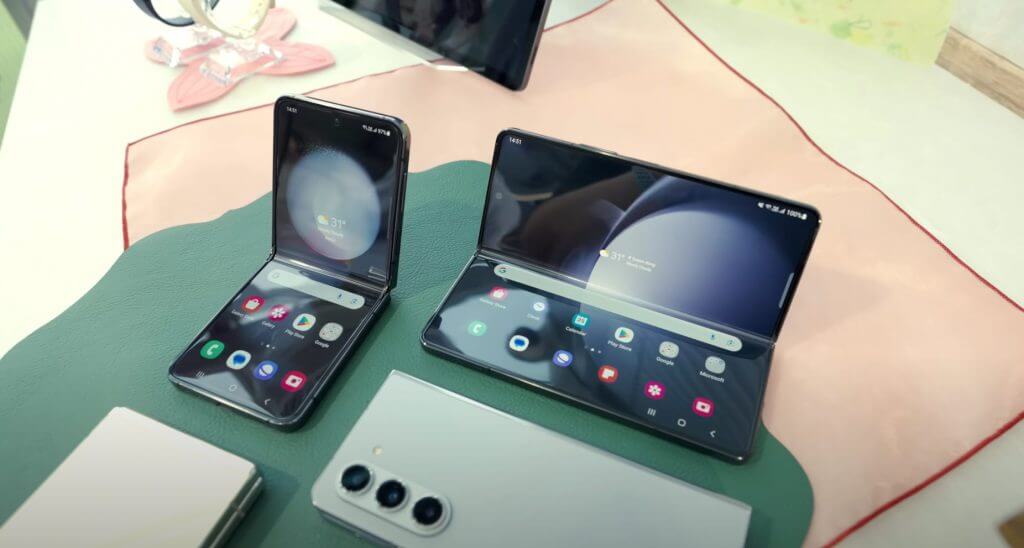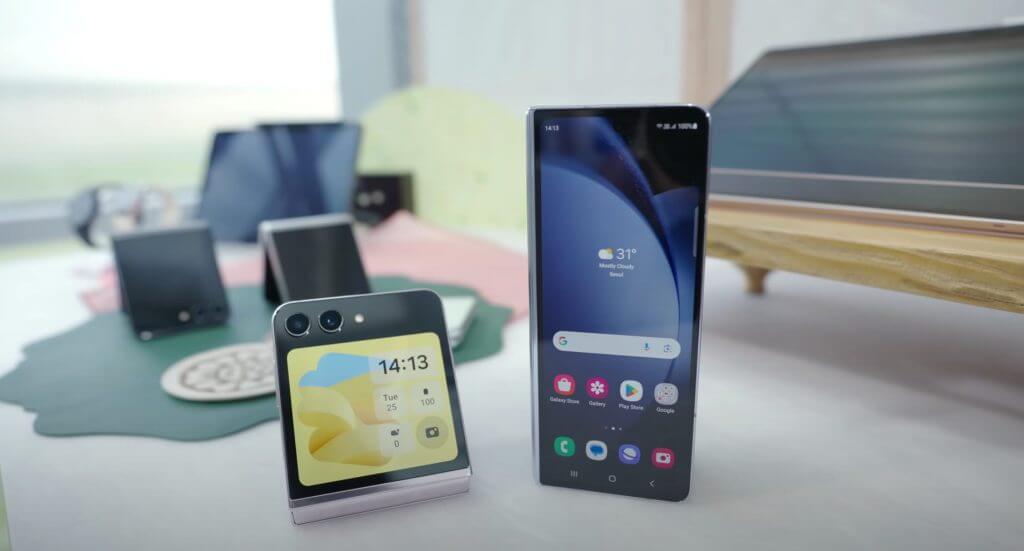Starting at $999.99
Cheaper, smaller, and more durable might be the better way to pitch the upcoming foldable surgency. The Flip5 offers all of the above with fewer compromises and a shorter learning curve than the Fold5, which makes its the ideal foldable to sell the masses.
OnMSFT was gifted a review unit of the Z Flip5 from AT&T with 5G sim and we took it for a spin for close to a month and the this year’s iteration of Samsung’s nostalgic folding experience is perhaps the most functional case for folding screen technology and should the device most people curious about folding phones get.
| Samsung Galaxy Z Fold5 | |
| Battery | 3700 mAh¹ |
| Wireless Power share | Yes |
| Storage Options | 256GB 512GB |
| Processor | Qualcomm Snapdragon 8 Gen2 Mobile Platform for Galaxy |
| RAM Options | 8GB |
| Pen Compatibility | No |
| Cellular & Wireless | 5G |
| Ultra Wide Camera | Yes |
| Resolution | Rear: 12MP Wide 12MP Ultra Wide 10X Digital ZoomFront: 10MP |
| Aperture | Rear: 12MP Wide(f/1.8) 12MP Ultra wide(f/2.2)Front: 10MP (f/2.2) |
| Flaw Detection | Yes |
| Ultrasonic Fingerprint Scanner | Capacitive FP |
| Display | 6.7” Dynamic AMOLED 2X Infinity Flex Display FHD+ 120Hz Adaptive Refresh Rate 425ppi, 1,750nits (Outdoor Peak) 3.4 Super AMOLED Display 748 x 720 60hz Refresh Rate 306ppi, 1,600nits (Outdoor Peak) |
Build Quality
5/5
The Samsung Galaxy Z Flip5 is now on its fifth iteration but for a first time flipable user, the device feels revolutionary by anecdotal comparison.
With Samsung improving the hinge design between the Flip4 and the Flip5, the latest version of the phone now closes flush and creates an even more pocketable metal and glass square that tucks neatly into most pockets, slings, sleeves, and purses. The Flip5 feels a bit more angular and edgy than the Flip4 with its squared off edges that mimic the same design language as the S23 and Z Fold5.
The unit I reviewed came in a gun metal black with a matching accented frame that broken up by solid black lines presumably representing Wi-Fi- bands.
Despite the dual glass make up of the front screen and back panel, the Z Flip5 doesn’t feel as slippery as it looks. The more angular design of the edges helps with grip in the hand and as a closed device, the phone is hefty pocket square the easy to hold.
However, the positioning of the volume rocker and power button take some getting used to when the device is closed due to their truncated centering. I’ve often accidentally triggered the screen, interrupted music sessions and hung up phone calls by forgetting where the keys were on this evenly sided square phone when it’s closed.
Once again, Samsung has perfected the rigidity of the hinge which keeps frictionless motion throughout the entire opening and closing experience, despite my tendency to violently flip open the phone one-handed like it was switch blade. The Flip5’s new Flex hinge range goes from 180 degrees when open to about 10 degrees before the magnets at the top and bottom of the phone begin to interact and force it shut.
As with almost all phones, the camera arrangement protrudes from the device, and on the Flip5 that protrusion is a mere couple of centimeters. Samsung has chosen to omit its customary 3 lens set up for the Flip5, instead opting for a dual lens arrangement and a flash that sit neatly tucked away in the bottom corner of the front screen when closed.
When opened, users are greeted with the full 6.7-inch FHD AMOLED display that feels good to the touch, but not quite glass-like. The edges of the Flip5 come up over the screen to provide a slight protective ridge around the screen.
The fold in the screen is noticeable at first glance but when content is on the screen the crease tends to fade into the background and only reappears when the device is off.
Between the squarish design and the heft of the phone when closed, the Z Flip5 feels astoundingly secure, enough so that I never felt the need to house it in a case or apply a protective screen to the device during my review.
Screen
5/5
There are two screens on the Z Flip and I’ll start with the less impressive one which surprisingly is the main 6.7-inch AMOLED display. Because it’s not actual glass, there was cognitive dissonance that developed using the main display, especially in contrast to the 3.4-inch Super AMOLED display on the front. Sure, the inner display has a higher refresh rate and can get brighter, but touch and feel of actual glass versus the foldable glass tech Samsung puts into the Flip and Fold’s main displays is constantly put in contrast to the front displays and just feels a bit off at times.
The main screen is also the place where the crease is present and dampens the user experience slightly, in contrast to the unobstructed experience on the front screen.
The difference between front and main screen technologies isn’t a game changer or a non-starter for me, nor do I think it will be for most, but it should be noted because it will be noticed.
Moving beyond the feel of the screens, the front display of the Z Fold5 now larger than its predecessor taking up 3.4-inches versus the previous display at 1.4-inches.
The main display of the Z Flip5 sports an unconventional 22:9 aspect ratio which makes its slightly taller and skinner than the traditional smartphone viewing experience. The skinnier aspect ratio helps with one-handed navigation across most of the screen but there will be elements at the very top and bottom of the phone that could require some users to master some one-hand jousting of the device to reach and interact with.
Despite its feel, Samsung’s Ultra-Thin Glass (UTG) tech is fairly resilient and shows no signs of wear from scratches or micro-abrasions that normal glass surfaces can suffer from when put into pockets or other cramped spaces.
With a boost in brightness this year, the main display was easy to view in direct sunlight and overall color reproduction was just as bright and punchy as all other Samsung phones have been known for.
The main attraction here however, is the front display that’s gotten its glow up in the form of more usable real estate. Despite being capped at 60Hz, the front screen was a delight to use. With real glass covering the Super AMOLED front display, items on the screen were crisp, easy to read and detailed. Doing things like watching movies or rummaging through photos was great experience, and never felt laggy or suffered from any noticeable latency.
Camera
3/5
I think camera reviews at this point are relative. I’m not one for pixel peeping or all that adapt at finding huge differences between color grades or signal to noise ratio (SNR) advances year over year, but the cameras on the Flip5 are a step down from the rest of Samsung’s 2023 flagship phone lineup. The mere fact that there are only two cameras present on the Flip5 versus the three that are present on the entire S-line and the Z Fold5 means Flip5 users are receiving a degraded camera experience.
In addition the lens are also a step down from the Z Fold5 that offer 50MP Wide and 200MP Wide respectively while the Z Flip5 uses a 12MP Wide. The Ultrawide experience is remains consistent across the three devices at 12MP and the zooms are the same. However, the Z Flip5 drops the telephoto lens which means fewer zoom levels for users who want to shoot far away subjects but retain clarity.
It’s unfortunate, but as I mentioned up top, camera reviews have become relative and the overall image quality and experience of the Z Flip5 cameras by comparison are still very good. Images from the two lenses on the Z Flip are crisp and boosted thanks to Samsung’s automatic filtering.
Ultrawide images are a bit fuzzy around the edges, but are still very presentable while the wide does a great job in daylit settings. Without a dedicated telephoto, images captured at 2x are excellent but anything beyond that become blurry bigfoot sightings. Low-light shots are as good as the users can keep their hands steady. Depending on how dark the area is the longer users need to hold steady, partly to compensate for a bit of Samsung’s famous shutter lag.
Fortunately, because of the design, users can use the rear cameras the same a front-facing camera and achieve much crisper looking selfies and video conferencing at 60 FPS and in FHD.
User Experience
5/5
Despite some minor compromises with the camera and the learning curve of a flipable foldable phone, the Z Flip5 presented an excellent user experience. Starting with the form factor itself, many will find the natural closed state of the Flip5 very enjoyable. An almost perfectly square sandwich of premium metal and glass that acts as the worlds best widget tool can’t be overstated.
The Flip5 is perhaps the most portable smartphone experience to-date and lives comfortably in the valley between smartwatch and smartphone as far usefulness and functionality. It has very strong but not overbearing haptics to alert users of notifications but is less of an visual or physical obstruction due to its truncated size.
In addition, the fact that the main screen is hidden away when closed is yet another traditional smartphone concern lifted off a users shoulders. The solid construction of the Flip5 meant I was able to toss the phone into any bag, pocket or sleeve and never having to give a second thought about keys, pens, bottles or other objects scratching the screen.
Intrinsic in the physical benefits of the phone is the embedded software that’s opened up a whole new digital minimalism when interacting with smartphones.
There is an undercurrent market of reformed smartphone users who are seeking a less obtrusive phone experience, stripped of all of the nagging notifications, doom scrolling and the subjective time sinks modern smartphones can encourage with devices such as the Punkt MP02, and even a Nokia 8210 4G.
The Flip5, while an excessively featured device, can offer a bit of that digital minimalism and mindful living through its widget-like nature. The front screen is very usable as the main interaction point for the Flip5’s experience and the installed widgets from Samsung provide basic information for everyday smartphone use such as messages, incoming and missed calls, calendar, timers, weather, stocks, fitness, and a couple of others.
Other native Samsung widget experiences include Netflix, YouTube, and Google Maps.
These widgets serve as quick and easily ingestible pieces of information and content and due to the truncated screen size and limited functionality, many people may find getting in and out of these experiences preferable to whack-a-mole app opening on more traditional phones. I know I did.
My anecdotal usage of the front screen and the main screen would leaned toward 60/40 on most days with the front screen getting most of my attention and on busy outdoor days, it was more like 80/20.
Samsung also offers an app found in the Play Store called Good Lock which will bring any app to the front screen for anyone who is taking baby steps towards a more mindful smartphone experience.
On several day-long trips to parks such as Universal and Disney, I found the Flip5 experience preferable to that of the Fold5 and most traditional smartphones. The phone was small enough to sit securely in my pockets on any ride and during countless squatting sessions, as well as altering my smartphone usage towards briefer interactions that freed me up to enjoy more present time with my wife and daughters.
Getting to the main screen, the Flip5 still offers a stellar traditional smartphone experience in this regard. Getting past the crease, the thinner, one-handed experience is also preferable in most instances, to that of wider traditional smartphones. The taller aspect ratio does mean it can still be a two handed affair in some app experiences, but for most open-and-scroll app types, the phone functions like any other.
The Flip5 can be opened one-handed, which is nice and the finality that comes when closing the phone that helps to put punctuation on the end of a specific interaction is a joy.
I’m not a selfie person buy my daughters are and preferred to use the Flip5 over my wife’s iPhone in almost every instance because it was quicker to get to and easier to frame and take shots as it sits in the palm of the hand with the shutter button within thumb reach.
The Snapdragon 8 Gen 2 makes the phone feel pretty snappy and the pile of customizations Samsung offers in the settings enables users to create the perfect limited or robust smartphone experience to their liking.
Another nicety of the Flip5 is the fingerprint reader on the power button. While I like the in-screen readers on the S-line up, I do miss being able to easily hit the power button to wake up the phone securely.
Battery Life
5/5
Battery on the Flip5 is surprisingly long in my use case, perhaps because of my 60/40 split between front and main screen I was conserving more battery than the average Flip5 user but I would end most my days with around 35-40% of power around 10:00pm. Even on long park days with lots of photos and videos, I dip to about 20% around the same time.
Samsung’s “Super-Fast Charging” tech is onboard and should get the Flip5 to 50% of battery life after 30 mins.
Summary
The Flip5 is a foldable phone for everyone.
The Fold5 offers a peak into the world of maximalist phone usage where the traditional smartphone experience can be augmented into a miniature tablet or desktop experience whereas the Flip5 offers the opposite but with less compromise than the Fold5.
The biggest annoyance for the Fold5 is the front screen that mimics a traditional smartphone experience while being to tall and thin to properly provide the same level of usage. Apps on the Fold5 can get their viewing experience cut off, typing is crunched, touch points become too small to interact with properly due to the resolution among other annoyances await Fold5 users, and while the Flip5 arguably offers even less functionality, it’s intended use is not to mimic the use of traditional smartphones initially but a more concerted glance-and-go approach to using modern smartphones.
Smartphone users who are used to the traditional slab phone can still get that same single screen, single app experience while also learning to embrace a proper way of interacting with widgets on the front screen.
Using the Flip5 feels intuitive in way the Fold5, Duo, and other expansive Foldables don’t, while still offering a “folding” experience.
If the plan is to get people in to interact with their phones in new ways to keep juicing an arguably stale market, I think more OEMs need to provide their version of flip foldables at reasonable price points rather than the mini tablet pitch.
Beyond a few niche cases, tablets have proven to be mostly recreational consumption devices and turning your most functionally useful personal computer into a averagely useful consumption device may have less backing than people looking to carry smaller phones that are more durable and offer better battery life.
In addition to its profound utility, the Flip5 is also offers premium smartphone experience without breaking the bank. While it starts at $999, carriers such as AT&T, Verizon and T-Mobile are offering trade-in and upgrade prices as high as $800 off on the phone.

